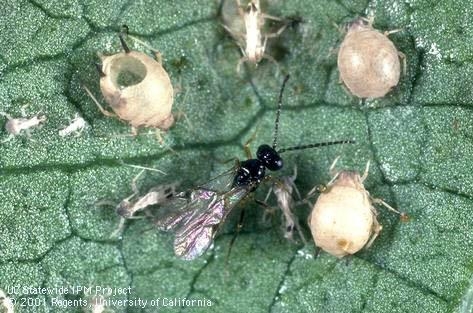Parasitic Wasps
By Polly Nelson UCCE Master Gardener
What are parasitic wasps? Sally S. San Luis Obispo
If parasitic wasps seem creepy, their beneficial contributions will convince you to welcome them to your garden. Parasitic wasps (PW) are tiny, non-stinging insects that parasitize their host, mostly other insects that feed on plants. PWs span over three dozen families within the order Hymenoptera. They are much smaller than the large stinging paper wasps, yellow jackets, and hornets commonly found around the yard.
Parasitic wasps are effective managers of aphids and other pests such as mealybugs, whiteflies, scale, and tobacco hornworms. One type of PW specializes in parasitizing only aphids. Tender new plant growth attracts aphids which then attract PWs. Females PWs lay one egg inside the aphid. After egg hatch, the larva feeds on internal tissues and secretes chemicals to transform the soft-bodied aphid into an aphid mummy – a bloated tan to dark brown colored shell. The larva completes its development safely inside the hardened aphid mummy and chews through the shell to create an exit hole. The PW emerges as an adult, mates, and looks for new hosts, all within its 2 to 3-week lifespan. Aphid mummies are easily spotted on plant foliage and are a tell-tale sign that PWs are present and at work in your garden.
Invite PWs to your garden by providing alternate food sources. Plants and shrubs with dense clusters of small flowers, such as Ceanothus and buckwheat, are among those recommended. Other choices include members of the carrot (Apiaceae) family, such as Queen Anne's Lace, dill, cilantro and fennel. Select a variety of plants with different boom periods to maintain a PW population throughout the year. Ant control around plants is imperative to allow PWs to do their jobs. Ants protect and defend honeydew producing pests and interrupt the activities of predators and parasitic wasps. If insecticides are necessary, look for those that pose the least risk to beneficial insects and always follow label instructions.
Welcome parasitic wasps to work with you and for you to improve the diversity and balance of your garden habitat.
For photos and more information on parasitic wasps and biological control, visit www.biologicalcontrol.info
